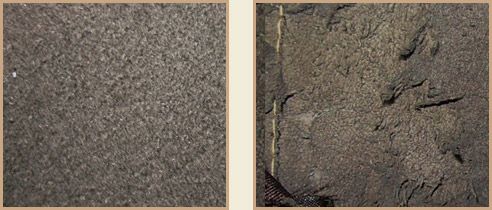The leather itself is, of course, the biggest factor. Most of what is on the market today in smooth leather is lamb or cowhide and these are almost always your best choices. Pigskin is not common in smooth leather, as it is usually tanned for suede which we don't recommend. (Click here for or more on suede.) Deer, elk, and moose are commonly made into garments, but not usually found in the stores, and are difficult to keep clean. Only occasionally will you find new garments made of goat. Most of these will likely will have a sprayed dye finish*.
Lambskin is beautiful, soft as butter, and feels like a second skin on you! There is nothing like a lamb jacket! However, lambskin can be delicate. Know that the least expensive of lamb coats may tear easily and the finish wear off quickly. Even so, if you find a lamb jacket you want for the style, fit, or feel - then buy it! Take it home and spray it with Aquila , or other water repellent for leather, and purchase some Tenderly to keep it moist. This will help keep it clean and looking nice. When the color begins to fade, since lamb is almost always vat dyed, it can be redyed by Leather CARE Specialists and made to look new again.
Cowhide is much tougher and the finish lasts longer. If you don't want to be concerned about jumping in the car or truck, being careful with the seat belt, or shoving your gloves in your pockets, you should buy a cowhide. New tanning processes are delivering some “lambtan” cowhides that are very close to the feel of lamb. If you prefer the luxury of lamb but need the practicality of cowhide you should consider these. Labels will still only say “100% Leather.” Ask your clerk to be sure of what you are buying. Keep a cowhide coat conditioned properly and you should have it to enjoy for a great many years.
Next, look for vat dyed leather as opposed to sprayed finish leather.
Check the leather panels. Does the leather have some body to it, a good moist look, and do the panels show consistency in cutting from the best sections of the hide? Take a fold and see if it feels smooth when you move it back and forth between your fingers. Check for quality skin (see the photos below) Very thin places should give themselves away. Also, skivers can leave hairline cuts that go almost though. You can usually spot these from the outside.
Check the panels at the pockets, elbows, and stress points for strength. If they seem thin or stretchy, look for a different jacket. The upper outside arms are one of the most common areas that we receive at Leather CARE Specialists for repairs. This area is susceptible to tears, so make sure these panels feel strong without weak spots (see photos).

Check the other materials and construction details. If the thread is dull, it is probably all cotton. You should be looking for bonded nylon to hold your coat together. Cotton wears wherever it rubs and you will end up with seams where the top thread is completely gone. Also, look to see if the stitching is back-stitched at the seam ends, and tight (indicating correct tension on top and bottom threads).
Are the buttons sewn securely with no loose ends? Are the snaps secure?
Is the zipper sewn in properly? A zipper that is set in too close to the stitch line (the zipper head drags or the head sticks) will result in faded worn edges. Also, if the zipper is not sewn in nice and flat, it will be problematic. It may split open, jam, or wear out quickly at the pin (see photo on Shipping Garments page).
A quality lining will have a very tight weave and quilted linings should use “lock” stitches.
Lastly, the price. Most likely you'll pay extra for a good coat, but it will be well worth it, and now, you are equipped to pick one!


 Back to Helpful Info
Back to Helpful Info